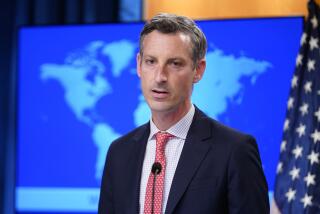U.S., Russia Cooperate on Y2K Concerns
- Share via
WASHINGTON — At a time when relations between the United States and Russia are at their frostiest in years, the possibility of a Y2K computer crisis is providing the two countries with a rare opportunity to bond on a high-priority issue: nuclear security.
So, while their leaders continue to talk past each other on issues such as Kosovo and Chechnya, military generals and top energy officials from the U.S. and Russia are working together to prevent nuclear accidents during the Year 2000 rollover.
With the help of modern technology, Energy Secretary Bill Richardson, in Washington, and Russian Atomic Energy Minister Yevgeny O. Adamov, in Moscow, held a news conference Wednesday to assure the world that there is no need to fear a Chernobyl-like nuclear catastrophe when Russia’s computers confront the new year.
U.S. and Russian military officials and nuclear energy specialists are planning joint operations to monitor any possible Y2K fallout during the changeover.
“Overall, U.S.-Russian relations have taken some hits in the last year,” said Rose Gottemoeller, U.S. assistant energy secretary for nonproliferation and national security. But she said that in the realm of nuclear issues, at least, the collaboration is thriving.
“That’s a continuing relationship that can be very strongly productive, despite what’s going on,” Gottemoeller said.
Security analysts agree that the links between technology specialists are essential now, given the grim state of U.S.-Russian relations.
“They’re sort of at Cold War levels--except that the Russians are not talking about the eventual triumph of communism,” said John Pike, a defense specialist at the Federation of American Scientists, a privately funded policy group in Washington. “The level of suspicions have not been this high since sometime in the early to mid-’80s.”
The spirit of goodwill that flourished for several years has been drained by America’s role in expanding the North Atlantic Treaty Organization and in bombing Yugoslavia--which has historic ties to Russia--and by what is perceived as U.S. meddling in internal Russian affairs by condemning Moscow’s war in the separatist republic of Chechnya.
“This means that restoring mutual confidence is very important,” said Bruce Blair, an arms-control specialist at the Brookings Institution, a Washington think tank. “These Y2K activities are sort of the last link that we maintain that contributes to mutual confidence.”
On New Year’s Eve, the emergency operations center in the basement of the Energy Department’s Washington headquarters will be in constant communication--via video link--with the crisis center at the Atomic Energy Ministry’s headquarters in Moscow.
A dress rehearsal of that linkup was staged Wednesday, and U.S. and Russian officials used the opportunity to highlight the collaborative work that has been underway over the last several months to make Russia’s 29 Soviet-designed nuclear reactors Y2K-ready.
The Y2K computer problem results because older computers were programmed to read only the last two digits of dates, so alterations must be made in the computer code to ensure that they do not malfunction by reading 2000 as 1900.
None of the primary safety systems in the Russian reactors is digital, so a computer glitch wouldn’t cause the kind of dreaded nuclear accident that would spew radioactive material into the atmosphere, Adamov and Richardson stressed.
The biggest fear is that Y2K troubles would cause an interruption in the electrical grids that supply the nuclear plants, but there are also concerns about Y2K-vulnerable computers inside the facilities that help operators monitor the reactors.
Adamov assured U.S. officials that Russia has checked the backup diesel generators at the plants, and he cited two recent major storms that knocked out power at two facilities without causing any major difficulties at the nuclear power plants.
Richardson said he is still concerned about contingencies that can’t be foreseen, such as the kind of human error that caused Japan’s worst nuclear disaster in September, when workers set off a fission reaction while loading excessive amounts of uranium into a tank.
“The linkup you see before us today is perhaps our best contingency plan of all,” Richardson said. “We have lines of communication for emergency responses in case there is a problem--no matter how remote that is.”
More to Read
Sign up for Essential California
The most important California stories and recommendations in your inbox every morning.
You may occasionally receive promotional content from the Los Angeles Times.













